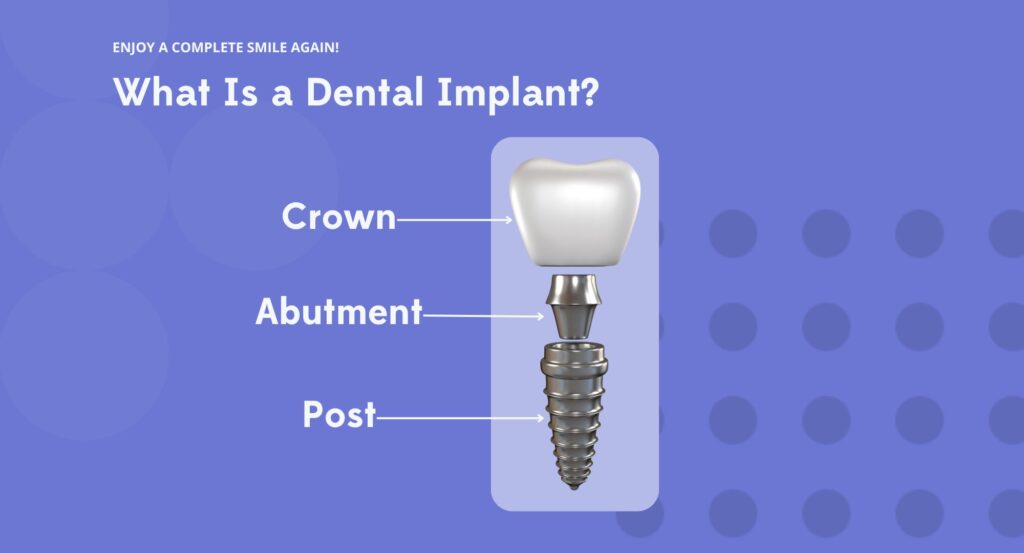What are dental implants?
Dental implants are a long-term solution for replacing missing teeth. They consist of three parts: a titanium post that acts as a tooth root, an abutment that connects the post to your restoration, and a crown, bridge, or denture that replaces the visible tooth. Made to blend seamlessly with your natural teeth, our custom dental implants in Redding and Red Bluff can restore both the look and function of your smile so you can get back to living life to the fullest!
Why choose dental implants to replace missing teeth?
Missing teeth can make daily activities like eating and smiling feel like a challenge. Dental implants solve these issues while offering several incredible benefits:
- Can last a lifetime with proper care
- Look and function like real teeth
- Protect surrounding teeth by avoiding unnecessary adjustments
- Help prevent jawbone loss and maintain facial structure
- Restore nearly 100% of normal chewing ability
- Provide a natural, confident smile
- Prevent teeth from shifting and creating alignment issues
- Reduce long-term dental expenses by preserving your oral health
Are dental implants worth it?
While dental implants may have a higher upfront cost than other options, their durability and minimal maintenance make them a worthwhile investment. Unlike traditional dentures, which often need frequent adjustments or replacements, dental implants are built to last.
They also help protect your natural teeth from additional wear or damage, saving you from costly dental work in the future. At Moore, Pascarella & Heinzen, we believe high-quality care should be accessible to everyone, so we proudly provide affordable dental implants in Redding and Red Bluff with flexible payment and financing options.
Are dental implants right for you?
Most people with missing teeth are excellent candidates for dental implants. If you’re in good oral health and have enough jawbone to support the implant, you’re likely a great fit. Even if additional steps like bone grafting are necessary, we can help prepare you for success.
During your consultation, our team will evaluate your oral health, review your medical history, and develop a treatment plan tailored to your needs. Together, we’ll work to restore your smile and confidence.

What is the process of getting dental implants?
Your journey to a renewed smile involves several steps, and we’re here to guide you every step of the way:
- Consultation: We’ll begin by understanding your goals and assessing your oral health. Using detailed imaging, we’ll determine the best approach to meet your needs.
- Customized Plan: Your personalized treatment plan may include tooth extractions or bone grafting to ensure a strong foundation for your implants.
- Implant Placement: The titanium post is surgically placed into the jawbone with precision and care, ensuring your comfort throughout the procedure.
- Healing: Over the following months, the implant naturally integrates with your jawbone, creating a solid base for your new teeth.
- Restoration: Once fully healed, we’ll attach a custom restoration to complete your smile.
At Moore, Pascarella & Heinzen, we prioritize your comfort and satisfaction at every step of the process.
How to care for dental implants
It’s just as important to care for your dental implants as it is your natural teeth.
To ensure your dental implants last as long as possible, follow these simple dental implant care instructions:
- Brush twice every day for at least two minutes per day with a soft toothbrush. If possible, use a high-quality electric toothbrush. Choose an angle-necked or other toothbrush that allows you to clean under and around your dental implants.
- Floss at least once per day. If you have a dental implant bridge, you may need floss threaders or specially designed crown and bridge floss to thoroughly clean under and around dental implants. Our team will give you full instructions on how to floss your new teeth.
- Using a water flosser instead of or in addition to traditional floss can help prevent peri implantitis – inflammation of the gum and bone structure around implants. Water flossers sweep debris and bacteria out from under fixed prostheses like full mouth dental implants, which can make it hard to clean between your permanent bridge and your gums.
- Only use low abrasive toothpaste without ingredients like baking soda or charcoal, which can damage the glaze from your restorations and dull their shine.
- Keep up with regular maintenance visits so we can maintain the health of your gums, prevent peri-implantitis (an inflammatory disease that can lead to implant failure), and monitor the health of your jawbone.
With these simple steps, you can enjoy your rejuvenated smile for life without needing to worry about uncomfortable adhesives, constant visits to your dentist for adjustments like relines, or the expense of replacing your prosthesis every few years.
Transform your smile with dental implants in Redding and Red Bluff
At Moore, Pascarella & Heinzen, we want to help you put your best smile forward. A complete smile of strong, functional teeth is essential to your quality of life and we’re here to make sure you get it. If you’re ready to rebuild your smile, reach out to us today to schedule a consultation for dental implants in Redding and Red Bluff.








